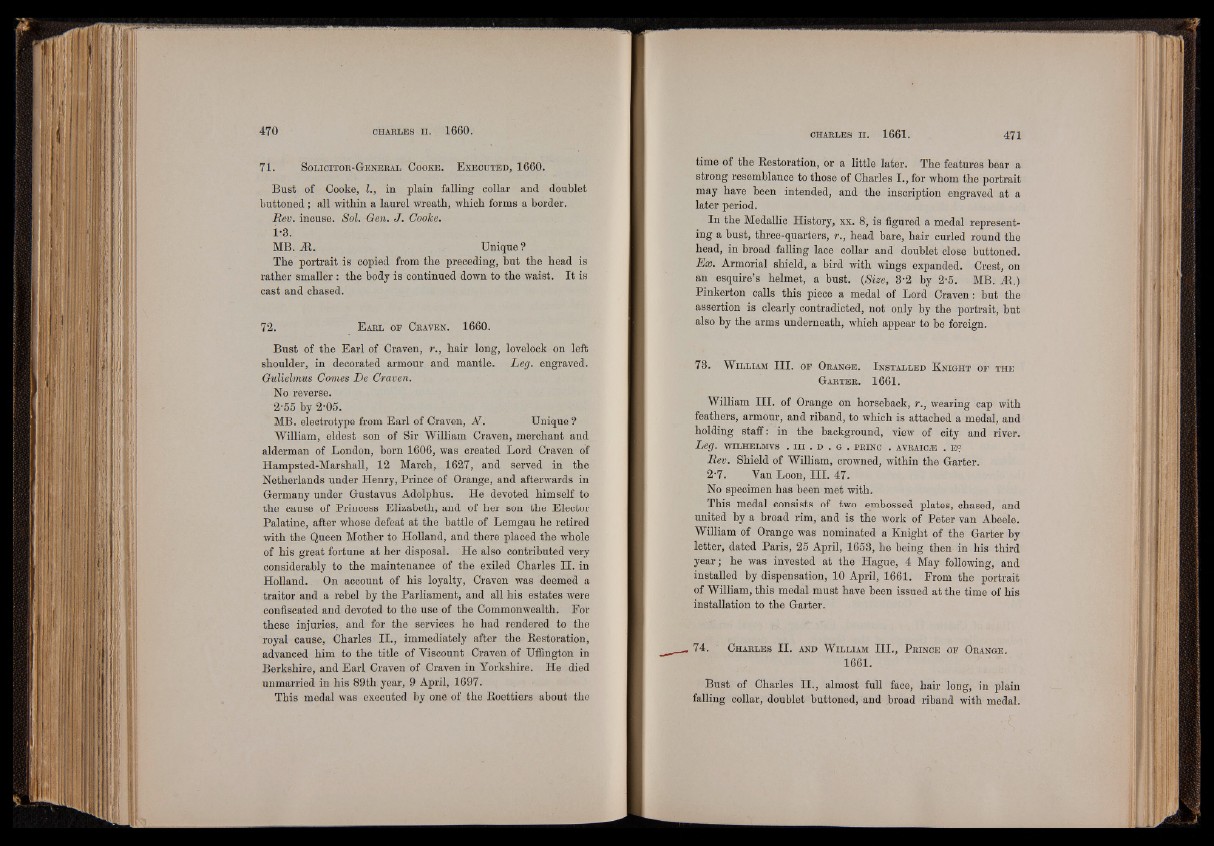
71. S o l ic it o r -G e n e r a l C o o k e . E x e c u t e d , 1660.
Bust of Cooke, I., in plain falling collar and doublet
buttoned; all within a laurel wreath, which forms a border.
Rev. incuse. Sol. Gen. J. Cooke.
1-3.
MB. M. Unique ?
The portrait is copied from the preceding, hut the head is
rather smaller : the body is continued down to the waist. It is
cast and chased.
7 2 . E a r l o f C r a ven . 1 6 6 0 .
Bust of the Earl of Craven, r., hair long, lovelock on left
shoulder, in decorated armour and mantle. Leg. engraved.
Gulielmus Comes De Craven.
No reverse.
2-55 by 2-05.
MB. electrotype from Earl of Craven, AL Unique ?
William, eldest son of Sir William Craven, merchant and
alderman of London, horn 1606, was created Lord Craven of
Hampsted-Marshall, 12 March, 1627, and served in the
Netherlands under Henry, Prince of Orange, and afterwards in
Germany under Gustavus Adolphus. He devoted himself to
the cause of Princess Elizabeth, and of her son the Elector
Palatine, after whose defeat at the battle of Lemgau he retired
with the Queen Mother to Holland, and there placed the whole
of his great fortune at her disposal. He also contributed very
considerably to the maintenance of the exiled Charles II. in
Holland. On account of his loyalty, Craven was deemed a
traitor and a rebel by the Parliament, and all his estates were
confiscated and devoted to the use of the Commonwealth. For
these injuries, and for the services he had rendered to the
royal cause, Charles II., immediately after the Restoration,
advanced him to the title of Viscount Craven of Uffington in
Berkshire, and Earl Craven of Craven in Yorkshire. He died
unmarried in his 89th year, 9 April, 1697.
This medal was executed by one of the Roettiers about the
time of the Restoration, or a little later. The features bear a
strong resemblance to those of Charles I., for whom the portrait
may have been intended, and the inscription engraved at a
later period.
In the Medallic History, xx. 8, is figured a medal representing
a bust, three-quarters, r., head bare, hair curled round the
head, in broad falling lace collar and doublet close buttoned.
Ex. Armorial shield, a bird with wings expanded. Crest, on
an esquire’s helmet, a bust. (Size, 8-2 by 2-5. MB. M.)
Pinkerton calls this piece a medal of Lord Craven: but the
assertion is clearly contradicted, not only by the portrait, but
also by the arms underneath, which appear to be foreign.
73. W il l ia m III. o f Or a n g e . I n s t a l l e d K n ig h t o f t h e
G a r t e r . 1661.
William III. of Orange on horseback, r., wearing cap with
feathers, armour, and riband, to which is attached a medal, and
holding staff: in the background, view of city and river.
Leg. WILHELMVS . I l l . D . G . PRINC . AVRAICIE . E?
Rev. Shield of William, crowned, within the Garter.
2-7. Van Loon, III. 47.
No specimen has been met with.
This medal consists of two embossed plates, chased, and
united by a broad rim, and is the work of Peter van Abeele.
William of Orange was nominated a Knight of the Garter by
letter, dated Paris, 25 April, 1653, he being then in his third
year; he was invested at the Hague, 4 May following, and
installed by dispensation, 10 April, 1661. From the portrait
of William, this medal must have been issued at the time of his
installation to the Garter.
7 4 . C h a r l e s II. and W il l ia m III., P r in c e o f Or a n g e .
1661.
Bust of Charles II., almost full face, hair long, in plain
falling collar, doublet buttoned, and broad riband with medal.